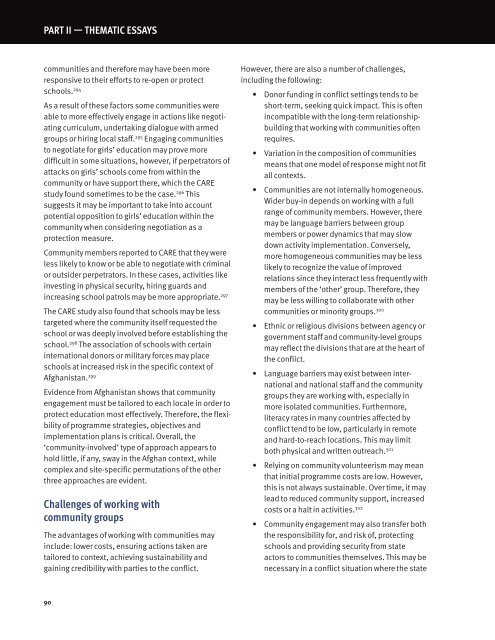You also want an ePaper? Increase the reach of your titles
YUMPU automatically turns print PDFs into web optimized ePapers that Google loves.
PART II — THeMATIC eSSAYScommunities and therefore may have been moreresponsive to their efforts to re-open or protectschools. 294As a result of these factors some communities wereable to more effectively engage in actions like negotiatingcurriculum, undertaking dialogue with armedgroups or hiring local staff. 295 Engaging communitiesto negotiate for girls’ education may prove moredifficult in some situations, however, if perpetrators ofattacks on girls’ schools come from within thecommunity or have support there, which the CAREstudy found sometimes to be the case. 296 Thissuggests it may be important to take into accountpotential opposition to girls’ education within thecommunity when considering negotiation as aprotection measure.Community members reported to CARE that they wereless likely to know or be able to negotiate with criminalor outsider perpetrators. In these cases, activities likeinvesting in physical security, hiring guards andincreasing school patrols may be more appropriate. 297The CARE study also found that schools may be lesstargeted where the community itself requested theschool or was deeply involved before establishing theschool. 298 The association of schools with certaininternational donors or military forces may placeschools at increased risk in the specific context ofAfghanistan. 299Evidence from Afghanistan shows that communityengagement must be tailored to each locale in order toprotect education most effectively. Therefore, the flexibilityof programme strategies, objectives andimplementation plans is critical. Overall, the‘community-involved’ type of approach appears tohold little, if any, sway in the Afghan context, whilecomplex and site-specific permutations of the otherthree approaches are evident.Challenges of working withcommunity groupsThe advantages of working with communities mayinclude: lower costs, ensuring actions taken aretailored to context, achieving sustainability andgaining credibility with parties to the conflict.However, there are also a number of challenges,including the following:• Donor funding in conflict settings tends to beshort-term, seeking quick impact. This is oftenincompatible with the long-term relationshipbuildingthat working with communities oftenrequires.• Variation in the composition of communitiesmeans that one model of response might not fitall contexts.• Communities are not internally homogeneous.Wider buy-in depends on working with a fullrange of community members. However, theremay be language barriers between groupmembers or power dynamics that may slowdown activity implementation. Conversely,more homogeneous communities may be lesslikely to recognize the value of improvedrelations since they interact less frequently withmembers of the ‘other’ group. Therefore, theymay be less willing to collaborate with othercommunities or minority groups. 300• Ethnic or religious divisions between agency orgovernment staff and community-level groupsmay reflect the divisions that are at the heart ofthe conflict.• Language barriers may exist between inter -national and national staff and the communitygroups they are working with, especially inmore isolated communities. Furthermore,literacy rates in many countries affected byconflict tend to be low, particularly in remoteand hard-to-reach locations. This may limitboth physical and written outreach. 301• Relying on community volunteerism may meanthat initial programme costs are low. However,this is not always sustainable. Over time, it maylead to reduced community support, increasedcosts or a halt in activities. 302• Community engagement may also transfer boththe responsibility for, and risk of, protectingschools and providing security from stateactors to communities themselves. This may benecessary in a conflict situation where the state90


